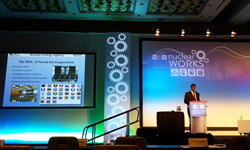 NEA Director‑General addresses the nuclear industry in Washington
NEA Director‑General addresses the nuclear industry in Washington
On 13‑14 May, the NEA Director‑General, Mr William D. Magwood, IV, featured among the invited speakers at the 62nd Nuclear Energy Assembly, the Nuclear Energy Institute's annual nuclear industry conference and expo. He spoke about "Nuclear Energy: Analyses of Today, Next Steps for Tomorrow" during the closing session on "Securing Our Future... Protecting Our Resources". During his presentation, he provided a series of international perspectives and trends in the nuclear field, from the regulatory, R&D and industry perspectives. The Agency's activities were featured throughout the exhibit at the NEA publications and information stand.
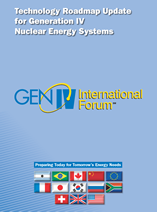 Generation IV International Forum (GIF) Symposium
Generation IV International Forum (GIF) Symposium
The third GIF Symposium took place on 19‑20 May 2015 in Makuhari Messe, Japan, jointly held within the 23rd International Conference on Nuclear Engineering (ICONE23), and was followed by the 39th GIF Policy Group meeting on 21‑22 May 2015. GIF symposia are organised triennially, with the first symposium held in France in 2009 and the second held in the United States in 2012. The 2015 symposium, which took place just over a year after the publication of the updated GIF Technology Roadmap, attracted about 100 participants. After an introduction by the GIF Chair Dr John Kelly, participants discussed progress made in the development of the six GIF systems, as well as in the three methodology working groups. The symposium ended with a lively question and answer session.
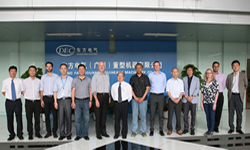 Multinational Design Evaluation Programme (MDEP) updates
Multinational Design Evaluation Programme (MDEP) updates
The MDEP Vendor Inspection Co-operation Working Group (VICWG) held its 15th meeting on 19‑22 May 2015 in Shenzhen, China. At the meeting, participants provided updates on regulatory activities in their respective countries and discussed planned vendor inspections for 2015‑2016 to provide an opportunity for other members to participate under the VICWG inspection protocol. The group also worked on the final drafts of the Multinational Vendor Inspection Assessment Technical Report and the VICWG Common Position on Vendor Oversight Good Practices, both of which are planned to be issued in 2015. The meeting also featured visits to the Dongfang (Guangzhou) Heavy Machinery Co. Ltd (DFHM) and the Taishan nuclear power plant construction site. During the visits, the group held meetings with the management and staff of both facilities to discuss vendor quality issues including counterfeit, fraudulent and suspect items (CFSI) in nuclear applications.
|
|
|
Nuclear reactor component experience, degradation and ageing
As water or steam runs through the components of a nuclear power plant, the metallic walls of pipes and vessels could gradually lose their thickness over the years and eventually raise a safety concern. The NEA Component Operational Experience, Degradation and Ageing Programme (CODAP) aims to collect and exchange information on relevant operational experience in order to identify effective techniques and technologies to manage and mitigate active degradation in nuclear power plants. At its meeting on 5-7 May 2015, the CODAP Program Review Group decided to expand its co-operation with the NEA Working Group on Risk Assessment (WGRISK), as well as with external organisations such as the International Atomic Energy Agency (IAEA), the European Commission (EC), the European Clearinghouse on Operating Experience Feedback for Nuclear Power Plants (NPPs) and the Nordic PSA Group (NPSAG). Participating countries were unanimous in their evaluation that the CODAP constitutes a valuable information resource not only for the national nuclear regulatory organisations but to stakeholders in the nuclear field as well.
Safety research opportunities post‑Fukushima
The NEA Committee on the Safety of Nuclear Installations (CSNI) has established a senior expert group to identify Safety Research Opportunities Post‑Fukushima (SAREF). In particular, the group aims to identify research activities that address safety knowledge gaps with information gained from the Fukushima Daiichi reactors, while also supporting safe and prompt decommissioning in Japan. The group met on 11‑15 May 2015 in Japan to allow Japanese organisations to share their plans and requirements for research activities. Members of the group were also provided an opportunity to visit the Fukushima site to see first-hand the challenges faced by Japan and the good progress it has made in remediating the consequences of the tsunami and accident. During the meeting, the group decided on a preliminary prioritisation of potential research areas and selected some to develop more detailed proposals of international co‑operation activities. The group will prepare a report with recommendations for safety research activities, which is planned to be issued in 2016.
Operational and regulatory aspects of nuclear criticality safety
The NEA Working Group on Fuel Cycle Safety (WGFCS) organised an international workshop on Operational and Regulatory Aspects of Criticality Safety (ORACS) on 19‑21 May 2015 in Albuquerque, New Mexico, together with the United States Nuclear Regulatory Commission (NRC) and the United States Department of Energy (DOE). During the three‑day workshop, participants discussed variations of the regulatory requirements and national practices on criticality safety applicable to operating and anticipated future nuclear facilities. Workshop participants also identified areas for future work, such as the deterministic and risk‑informed approaches in safety assessment, national differences in applying defence‑in‑depth and double consistency principles in nuclear facilities, the need for more research on the use of burn-up credit in licensing of spent fuel repositories and the need for extensive co-operation to harvest selected criticality events stored in national databases for the international FINAS database.
Nuclear fuel fragmentation, relocation and dispersal
On 20‑21 May 2015, the NEA Halden Reactor Project and the NEA Working Group on Fuel Safety (WGFS) held a joint workshop in Aix‑en‑Provence, France, on fuel fragmentation, relocation and dispersal (FFRD) in the primary system induced by (recovered) loss‑of‑coolant accidents. The workshop brought together 87 participants from 15 countries, the International Atomic Energy Agency (IAEA) and the NEA. Presentations provided the latest knowledge from modelling and experiments encompassing BWR, CANDU‑PHWR and PWR (including VVER) fuels. Over the past decade, several international research programmes, such as the NEA Halden Reactor Project, which address the behaviour of high burn‑up fuels in LOCA conditions have generated experimental observations that are somewhat beyond the current analysis capabilities of computer codes. The influence of running fuels to higher burn‑ups on the extent of FFRD has renewed safety questions on the potential impact on coolability, criticality and other phenomena.
Economics of nuclear energy
On 28 May 2015, the NEA Working Party on Nuclear Economics (WPNE) met to discuss the status of activities from the Programme of Work under WPNE oversight, as well as the United Nations Climate Change Conference, COP21, which will be held in Paris, France from 30 November to 11 December 2015. Key topics of discussion at the meeting included the WPNE reports in preparation, such as Projected Costs of Generating Electricity — 2015 Update; Nuclear New Build: Insights into Financing and Project Management; Market Study of Small Modular Reactors; Costs of Decommissioning Nuclear Power Plants; and Estimation of Potential Losses Due to Nuclear Accidents. Participants also examined the group's ongoing activities on the role and economics of nuclear cogeneration in a low‑carbon energy future; dealing with system costs in decarbonising electricity systems: policy options; and the full costs of electricity provision.
2015 International ISOE Symposium
The 2015 Information System on Occupational Exposure (ISOE) International ALARA Symposium on Occupational Exposure Management at Nuclear Facilities was held in Rio de Janeiro, Brazil on 26‑28 May 2015, organised by the IAEA Technical Centre (IAEA‑TC) and co-sponsored by the NEA, in collaboration with the Institute of Radiation Protection and Dosimetry (IRD), Eletronuclear and the Brazilian Radiological Protection Society (SBPR). The symposium was attended by 67 participants from 13 ISOE countries and representatives from all ISOE Technical Centres and the Joint NEA-IAEA Secretariat. It featured technical papers on the latest approaches in radiation protection management, dosimetry and monitoring, regulatory issues in the design and planning stages, source‑term management, radiation protection in decommissioning and job‑specific experiences for different type of reactors with benchmarking ISOE data from previous years. Argentina and Bangladesh were represented in the symposium for the first time and presented high quality papers. A technical tour to the Angra nuclear power plant was organised in conjunction with the symposium in order to facilitate information exchange on the operation of units 1 and 2 and the construction of unit 3.
Nuclear energy and women's perspectives
On 19 May 2015, the NEA participated in the International Symposium on "Discussions on Nuclear Energy from the Female Point of View", which took place in Tokyo, Japan and was co‑organised by the National Graduate Institute for Policy Studies (GRIPS), the Economic Research Institute for ASEAN and East Asia (ERIA), the Institute of Energy Economics, Japan (IEEJ) and the Breakthrough Institute. The symposium featured female experts in the nuclear field, such as operators, scientists, plant engineers, radiologists, climate change experts and administrators, who discussed women's points of view on the role of nuclear energy, as well as on policy objectives regarding climate change, safety measures and communicating with the general public. Mrs Ximena Vásquez‑Maignan, Head of the NEA Office of Legal Counsel, was a speaker in the panel discussion on climate change and nuclear energy. Her presentation addressed the 2015 edition of the IEA/NEA Technology Roadmap: Nuclear Energy, and focused on the role of nuclear energy in helping to mitigate climate change.
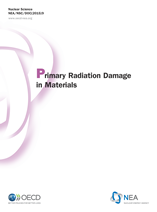 Multi-scale modelling of fuels and structural materials for nuclear systems
Multi-scale modelling of fuels and structural materials for nuclear systems
On 5‑7 May 2015, the NEA Working Party on Multi-scale Modelling of Fuels and Structural Materials for Nuclear Systems (WPMM) held its annual meeting. Established in 2008, this working party assesses the scientific and engineering aspects of fuels and structural materials and aims to promote multi‑scale models and simulations as validated predictive tools for the design of nuclear systems, fuel fabrication and performance. The highlight of the meeting was the progress made on two state‑of‑the‑art reports on multi‑scale modelling of fuels and on structural materials modelling, both of which are expected to be issued in the coming months, following the release this month of a report on "Primary Radiation Damage in Materials". Participants at the meeting also approved a new activity on the review of experimental techniques and modelling methods for determining irradiation effects in structural nuclear materials.
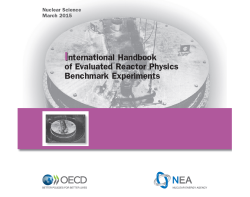 Experimental Criticality and Reactor Physics Benchmarks
Experimental Criticality and Reactor Physics Benchmarks
New expert group on liquid metal technology
On 19‑20 May 2015, the new NEA Expert Group on Liquid Metal Technology (EGLM) held its first meeting. The group has replaced the NEA Expert Group on Heavy Liquid Metal Technology (EGHLM), which had been active for several years and whose main objective was to issue a handbook including a collection of theoretical approaches and experimental data in order to deliver recommendations relevant for the design of HLM nuclear systems. Following the completion of the second version of the handbook, the group decided to review its scope and future activities. As suggested by the NEA Working Party on Scientific Issues of the Fuel Cycle (WPFC), it has been decided to form a new expert group which will include liquid sodium activities in its work plan. The new group will aim to take the next step in the assessment of available data to bring it closer to application in design, construction and licensing issues, as well as for operation, in‑service inspection, handling and maintenance.
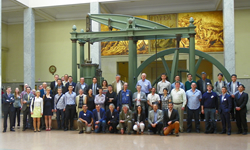 Uncertainty analysis in modelling for nuclear reactor safety
Uncertainty analysis in modelling for nuclear reactor safety
The NEA Expert Group on Uncertainty Analysis in Modelling (EGUAM) held a series of joint workshops on 18‑22 May 2015 in Spain, hosted by the Universidad Politécnica de Madrid (UPM) at the Escuela Técnica Superior de Ingenieros Industriales (ETSII). Workshops held included meetings on the Oskarshamn‑2 Boiling Water Reactor (O2‑BWR) stability benchmark, the Light Water Reactor Uncertainty Analysis in Modelling (LWR‑UAM) benchmark and the new Sodium Fast Reactor Uncertainty Analysis in Modelling (SFR‑UAM) benchmark. These benchmarks are helping to address the chain of uncertainty propagation from basic data, measurement and engineering uncertainties, both across different scales (multi‑scale) and physics phenomena (multi‑physics). Over 100 participants from the international reactor modelling community participated in these workshops and the growing number of participants in NEA uncertainty analysis activities highlights the increasing importance of uncertainty analysis in modelling to reactor scientists and the industry.
International nuclear data evaluation co‑operation
The NEA Working Party on International Nuclear Data Evaluation Co-operation (WPEC) held its annual meeting on 18‑22 May 2015, bringing together over 85 experts from 15 countries and five international organisations. Participants discussed technical issues related to evaluation methodologies of fission product yields, the definition of a modern database structure, methods and approaches to provide feedback from nuclear and covariance data adjustments, and improving nuclear data accuracy of 241Am and 237Np capture cross‑sections. They also evaluated nuclear data advances in the CIELO (Collaborative International Evaluated Library Organisation) Pilot Project focusing on six important isotopes –1H, 16O, 56Fe, 235,238U and 239Pu. Another highlight of the meeting was the updates from the WPEC Subgroup C which maintains the NEA Nuclear Data High Priority Request List (HPRL) and is currently working to implement new Special Purpose Quantities and to identify important information to be requested. At the meeting, the WPEC launched a new subgroup to work on Thermal Scattering Kernel S(α,β). Delegates also reviewed the status of experimental activities, the progress from evaluation projects and future plans, and the status of ongoing subgroups.
|
An online archive of previous editions is available here.
The monthly bulletin only lists new and updated material. It is distributed by e-mail to registered users of the Nuclear Energy Agency's Online Services. Registration is free; please use this link.